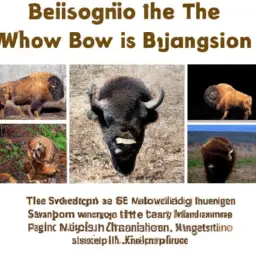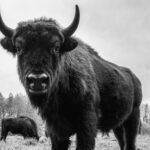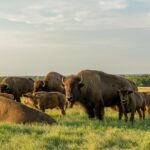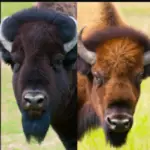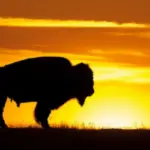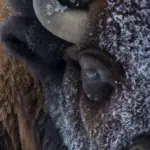Have you ever wondered about the factors that led to the remarkable evolution of bison? From their early ancestors to the majestic creatures roaming the plains today, there are countless factors that have shaped the evolution of these magnificent creatures. In this article, we will explore the key factors that contributed to bison evolution, shedding light on their fascinating journey through time. So, buckle up and get ready to embark on a journey into the world of bison evolution!
Environmental Changes
Climate Variations
Climate variations played a significant role in the evolution of bison. As the climate changed over millions of years, bison had to adapt to survive in different environmental conditions. These variations included changes in temperature, precipitation patterns, and the availability of water sources. Bison populations had to develop physiological and behavioral adaptations to thrive in the harsh winters of the Northern Plains and the hot, arid conditions of the Great Basin.
Habitat Alterations
Habitat alterations also affected the evolution of bison. The expansion and contraction of grasslands, forests, and other types of habitats influenced the distribution and abundance of bison populations. As habitats transformed and fragmented, bison had to navigate through different landscapes, adapting to feed on diverse plant species and finding suitable areas for shelter and breeding. Habitat alterations also created opportunities for human interactions and influenced the dynamics of predation pressures.
Availability of Food Sources
The availability of food sources played a critical role in the evolution of bison. Bison are herbivores and primarily feed on grasses. However, the vegetation composition and productivity of their habitats changed over time. Bison had to adapt to different types of grasses and plants, utilizing their flexibility in food preferences to ensure survival. Changes in the availability of food sources were influenced by climate variations, habitat alterations, and the interactions with other herbivore species.
Predation Pressures
Human Hunting
Human hunting exerted significant predation pressure on bison throughout history. Indigenous people relied on bison for food, clothing, and other resources, which led to extensive hunting practices. European settlers later intensified hunting for hides and to control native populations. As a result, the number of bison drastically declined, pushing them to the brink of extinction. The hunting pressure forced bison to evolve specific behaviors, such as heightened vigilance and herding strategies, to enhance their survival chances.
Predation by Wolves and Other Carnivores
Apart from human hunting, predation by wolves and other carnivores influenced bison evolution. Wolves were one of the main predators of bison, particularly before human settlements altered predator-prey dynamics. Bison had to develop strategies to evade predation, such as forming tight defensive formations called “bison circles.” The interaction between bison and carnivores shaped the physical traits and social behaviors of both species, contributing to their coevolution.
Predation-Evasion Adaptations
Bison evolved predation-evasion adaptations to increase their survival chances. Their size, strength, and relatively high speed make adult bison formidable adversaries for predators. They use their massive bodies and sharp horns to defend against attacks. Bison exhibit collective defense behaviors, such as forming tight-knit groups, also known as “bison circles,” to deter predators. Additionally, bison’s excellent sense of smell and acute hearing allow them to detect and evade predators in their surroundings.
Genetic Factors
Genetic Diversity and Health
Genetic diversity played a vital role in the evolution and overall health of bison populations. It allowed for greater adaptability and resilience to environmental changes, diseases, and other challenges. However, with the severe reduction in bison numbers due to hunting and habitat loss, genetic diversity declined significantly. This loss of genetic diversity posed a threat to the long-term survival and health of bison populations. Conservation efforts have focused on maintaining and restoring genetic diversity to ensure the resiliency of these iconic animals.
Essential Genetic Mutations
Essential genetic mutations have shaped the evolution of bison populations. These mutations have contributed to the development of unique traits that enhanced their survival and reproductive success. For example, mutations in genes associated with heat tolerance, resistance to diseases, and adaptations to different food sources have allowed bison to thrive in diverse habitats. The occurrence and inheritance of these essential genetic mutations have resulted in the diversity of bison populations found today.
Adaptations Through Genetic Changes
Genetic changes facilitated crucial adaptations in bison populations. Through natural selection, genetic variations that provided advantages in specific environments were favored and propagated over generations. Examples of genetic adaptations include traits related to cold tolerance, drought resilience, efficient digestion of fibrous plant material, and disease resistance. Genetic changes, occurring over thousands of years, have improved the overall fitness and survival chances of bison populations.
Influence of Human Activities
Over-Hunting by Humans
The influence of human activities on bison evolution cannot be overlooked. Over-hunting by humans, especially during the 19th century, severely impacted bison populations. The mass slaughter of bison for their hides, tongues, and to control Indigenous populations resulted in a drastic reduction in numbers. This human-induced pressure forced bison to adapt to the new reality of their environment, facing increased hunting pressures and altered social dynamics.
Effects of Agriculture and Land Development
The advent of agriculture and land development contributed to significant habitat modifications for bison. The conversion of vast grasslands into agricultural fields and urban areas disrupted the natural landscape that bison had relied on for thousands of years. This forced bison to adapt to smaller and more fragmented habitat patches, which affected their ability to find suitable food sources, breeding grounds, and shelter. The encroachment of human activities also increased the likelihood of human-bison conflicts.
Influence of Human-Mediated Translocations
Human-mediated translocations, such as reintroductions and relocations, have influenced the evolution of bison populations. These efforts aimed to restore bison populations in areas where they had been extirpated or to establish new populations in suitable habitats. Translocations involved selecting genetically diverse individuals from different populations, introducing new genes and traits into recipient populations. These genetic exchanges allowed for greater adaptability to differing environments and helped maintain genetic diversity in bison populations.
Adaptation to Different Diets
Flexibility in Food Preferences
Bison have demonstrated flexibility in their food preferences, enabling them to adapt to different diets over time. While bison are predominantly grazers, they can shift their feeding habits depending on the availability of food sources. During harsh winters when grasses are scarce, bison can switch to browsing on shrubs and tree parts. They can also utilize a wide variety of grass species, ensuring they can find suitable food in different habitats and seasons.
Physiological Adaptations for Different Diets
Physiological adaptations have supported bison’s ability to adapt to different diets. Their digestive system is highly efficient at extracting nutrients from fibrous plant material, which allows them to digest low-quality forage that many other herbivores can’t process. Additionally, bison possess a large, multi-chambered stomach that aids in the breakdown of cellulose. These adaptations enable them to thrive even when food availability fluctuates or when they encounter novel plant species.
Effects of Changing Food Availability
Fluctuations in food availability have driven adaptations in bison populations. When faced with reduced food resources, bison have evolved to become more efficient grazers, making the most of the available grasses. This has been achieved through changes in tooth structure and changes in feeding behavior, allowing them to rapidly graze larger areas and efficiently extract nutrients. These adaptations have helped bison persist in a variety of habitats with varying levels of food availability.
Natural Selection and Survival of the Fittest
Role of Competition in Natural Selection
Competition has played a crucial role in shaping the evolution of bison. In their natural habitats, bison compete with other herbivores for limited resources such as food, water, and shelter. This competition drives natural selection, favoring individuals that possess advantageous traits for resource acquisition and survival. Bison with traits like efficient foraging, predator detection, and reproductive success have a higher likelihood of passing on their genes to future generations.
Survival Skills and Reproductive Success
Survival and reproductive success are closely linked to the fitness of bison individuals. Bison with superior survival skills, such as effective predator evasion strategies and ability to detect favorable environmental conditions, have higher chances of surviving to reproduce. Successful reproduction, in turn, contributes to the expansion and persistence of their genetic traits in the population. The interplay between survival skills and reproductive success is a fundamental factor in the evolutionary process of bison.
Adaptations for Increased Fitness
Adaptations that increase fitness have been favored through natural selection in bison populations. As individuals with advantageous traits survive and reproduce more successfully, these traits become more prevalent in subsequent generations. Fitness-enhancing adaptations in bison include physical characteristics like larger body size for defense against predators, specialized sensory organs to detect threats, and efficient energy utilization for prolonged migration and seasonal breeding.
Geographical Isolations
Effects of Physical Barriers
Physical barriers have resulted in geographical isolations that influenced bison evolution. Natural features such as mountain ranges, rivers, and other bodies of water have created separations between bison populations. These barriers hindered gene flow between different groups, leading to the formation of distinct subspecies. Geographical isolation resulted in the divergence of genetic traits, helping create unique adaptations in bison populations inhabiting different regions.
Gene Flow Between Populations
Gene flow, or the exchange of genetic material between populations, is a crucial factor in shaping bison evolution. While physical barriers can limit gene flow, there are instances where bison populations have come into contact and exchanged genes. This gene flow helps maintain genetic diversity within and between bison populations, allowing for adaptation to shifting environments and reducing the risk of inbreeding. Gene flow plays a significant role in the long-term survival and evolutionary potential of bison.
Formation of Distinct Subspecies Due to Isolation
The geographical isolation caused by physical barriers has led to the formation of distinct subspecies of bison. The separate evolution of these subspecies in different regions has resulted in unique adaptations and characteristics. For example, the wood bison, found in northern regions with colder climates, has evolved to withstand harsh winters and deep snow. The distinct subspecies illustrate how the interplay between geography, gene flow, and adaptation has shaped the diversity of bison populations.
Sexual Selection
Competition for Mates
Sexual selection has played a significant role in the evolution of bison. Male bison engage in intense competition for mating opportunities, ranging from aggressive displays to direct physical confrontations. Dominant males have a higher chance of mating and passing on their genes to the next generation, leading to the evolution of traits that enhance competitiveness, such as larger body size and more impressive horns. Competition for mates has driven the evolution of sexually selected traits in male bison.
Traits Preferred by Mates
Mates in the bison population exhibit preferences for specific traits when selecting partners. Female bison select mates based on a variety of factors, including physical condition, fighting ability, and resource acquisition skills. Traits that indicate strong genetic quality, such as symmetrical horns and overall physical health, are often preferred by female mates. These preferences play a role in shaping the evolution of those characteristics through time.
Effects of Polygamy on Genetic Diversity
The polygamous mating system of bison has both benefits and consequences for their genetic diversity. Polygamy, where individuals have multiple mates, increases genetic diversity by allowing for more genetic variation to be passed on to offspring. It also influences the mating dynamics within bison populations, leading to competition among males for mates. However, the monopolization of mating by a few dominant males can reduce the genetic diversity within a population. The complex interplay between polygamy and genetic diversity contributes to the evolutionary trajectory of bison populations.
Disease Resistance
Survival of Disease-Resistant Individuals
Disease resistance has been a crucial factor in the survival of bison individuals and populations. Bison have faced diseases such as brucellosis, tuberculosis, and anthrax, which have caused significant declines in their numbers. However, over time, individuals with genetic traits of disease resistance have had a higher chance of surviving and passing on their genes. As a result, populations have developed natural resistance to certain diseases, enhancing their overall fitness and survival.
Disease-Resistance Genes and Inheritance
The presence of disease-resistance genes in bison populations has allowed for the inheritance of advantageous traits related to immunity. These genes enable bison to recognize and respond effectively to pathogens, providing them with a survival advantage in the face of disease outbreaks. Through the process of natural selection, bison with disease-resistance genes have been favored, leading to the persistence and spread of these crucial genetic traits through generations.
Role of Diseases in Bison Population Declines and Recoveries
Diseases have played a significant role in bison population declines and recoveries throughout history. Historical outbreaks of diseases like brucellosis and tuberculosis caused significant reductions in bison numbers. However, natural selection and the development of disease resistance have allowed populations to rebound and recover. The ongoing monitoring and management of diseases in bison populations are crucial for their long-term survival and well-being.
Could the Evolution of Bison Contribute to Their Strength?
The evolution of bison has led to them being one of the strongest animals in North America. Despite their large size, bison are incredibly agile and powerful, able to run at speeds of up to 40 miles per hour and jump fences as high as 6 feet. This is a testament to how strong bison is.
Inter-Species Interactions
Competition with Other Herbivores
Interactions with other herbivore species have shaped the evolution and behavior of bison. Bison often compete with other large herbivores such as elk and pronghorn for food resources. This competition influences the grazing patterns, movement, and resource utilization strategies of both bison and other herbivores. The coexistence and competition with other herbivores have influenced the feeding behavior, habitat selection, and social dynamics of bison populations throughout their evolutionary history.
Effects of Predators on Bison Behavior and Physical Traits
Interactions with predators have significant effects on the behavior and physical traits of bison. Predators such as wolves have driven the development of defensive behaviors in bison, such as forming bison circles or seeking refuge in water bodies. Bison have also evolved physical traits like large body size and horns as defense mechanisms against predators. The presence and predation pressures of carnivores have shaped the adaptive responses and survival strategies of bison populations.
Interactions with Non-Predator Species
Bison also interact with non-predator species, influencing their behavior and ecological dynamics. For instance, bison grazing and movements can shape vegetation communities, impacting the composition and structure of habitats. Their wallowing behavior creates distinct microhabitats that benefit other species, such as birds and insects. These interactions with non-predator species have ecological implications, contributing to biodiversity and shaping the evolutionary trajectories of multiple organisms within their ecosystems.
In conclusion, the evolution of bison has been shaped by a combination of environmental changes, predation pressures, genetic factors, human activities, adaptation to different diets, natural selection, geographical isolations, sexual selection, disease resistance, and inter-species interactions. These factors have influenced the behaviors, traits, and genetic diversity of bison populations over millions of years. Understanding the complex interplay between these factors is essential for effective conservation and management strategies to ensure the long-term survival and ecological significance of these magnificent animals.

